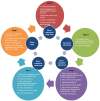Questionnaire Survey on the Current Situation and Experience in Prevention and Control Measures at Urology Clinics During the COVID-19 Epidemic in China
- PMID: 34490178
- PMCID: PMC8417710
- DOI: 10.3389/fpubh.2021.670889
Questionnaire Survey on the Current Situation and Experience in Prevention and Control Measures at Urology Clinics During the COVID-19 Epidemic in China
Abstract
COVID-19, the coronavirus disease 2019; SARS-CoV-2, the coronavirus 2; ACE2, angiotensin converting enzyme 2; S protein, spiked glycoprotein; TMPRSS2, transmembrane serine protease 2; WHO, World Health Organization. Purpose: Although the coronavirus disease 2019 (COVID-19) pandemic, caused by the severe acute respiratory syndrome coronavirus 2, has been viably controlled in China, a new normal in healthcare strategies has become standard in China and worldwide. We conducted a questionnaire study to disseminate the experience from China in terms of urology outpatient prevention and control measures under standardized prevention policies against COVID-19. Participants and Methods: From May 3, 2020 to June 25, 2020, we conducted an anonymous cross-sectional questionnaire study, focused on the status of and experiences with outpatient urology prevention and control measures during the COVID-19 pandemic. The targeted respondents were urologists in mainland China, covering all levels of hospitals and clinics. Results: A total of 216 (97%) valid responses were collected. We found that 183 (85%) respondents were from outside of Hubei province in China. One-hundred-and-fifty-eight (73%) respondents believed that SARS-CoV-2 could be detected in urine, and that protection against urine exposure was needed. Over 80% of respondents recommended WeChat application or similar online video meetings for virtual outpatient consultations. The suggested flowcharts and recommendations to prevent new cases were easy to understand and approved by most physicians, which could provide reference for outpatient prevention and control. We still need to make adequate preparations under the new normal of the COVID-19 Epidemic, especially for those suspected of being infected. Conclusions: Although the scientific validation of the questionnaire is limited, it provides a first snapshot of the experiences relating to the prevention and control measures in urology clinics in China, and can inform future policies in this field.
Keywords: COVID-19; SARS-CoV-2; epidemic; experience; questionnaire; urological outpatient.
Copyright © 2021 Zhu, Jiang, Jiang, Liu, Sheng, Liu and Wang.
Conflict of interest statement
The authors declare that the research was conducted in the absence of any commercial or financial relationships that could be construed as a potential conflict of interest.
Figures
Similar articles
-
A Global Survey on the Impact of COVID-19 on Urological Services.Eur Urol. 2020 Aug;78(2):265-275. doi: 10.1016/j.eururo.2020.05.025. Epub 2020 May 26. Eur Urol. 2020. PMID: 32507625 Free PMC article.
-
Participation in Virtual Urology Conferences During the COVID-19 Pandemic: Cross-sectional Survey Study.J Med Internet Res. 2021 Apr 21;23(4):e24369. doi: 10.2196/24369. J Med Internet Res. 2021. PMID: 33844635 Free PMC article.
-
A snapshot of public knowledge of novel coronavirus disease 2019: a web-based national survey.BMC Public Health. 2021 Mar 9;21(1):471. doi: 10.1186/s12889-021-10495-4. BMC Public Health. 2021. PMID: 33750356 Free PMC article.
-
The Coronavirus Disease 2019 (COVID-19) Pandemic.Tohoku J Exp Med. 2020 Apr;250(4):271-278. doi: 10.1620/tjem.250.271. Tohoku J Exp Med. 2020. PMID: 32321874 Review.
-
[Viral infections in urology].Urologe A. 2021 Sep;60(9):1150-1158. doi: 10.1007/s00120-021-01589-3. Epub 2021 Jul 6. Urologe A. 2021. PMID: 34228144 Free PMC article. Review. German.
References
Publication types
MeSH terms
LinkOut - more resources
Full Text Sources
Medical
Miscellaneous




